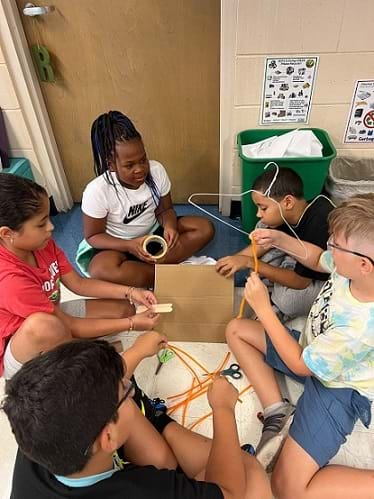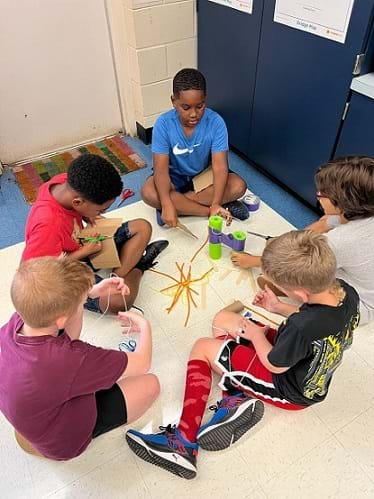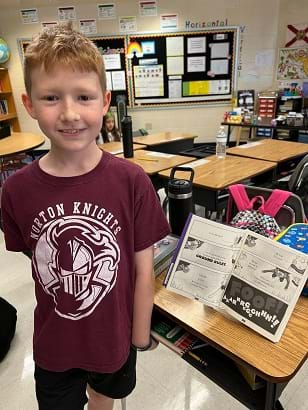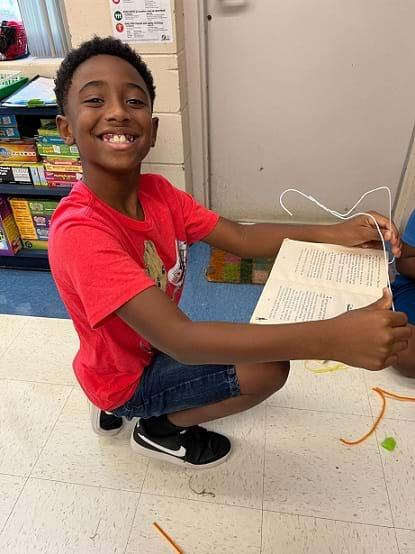Quick Look
Grade Level: 2 (1-2)
Time Required: 1 hours 30 minutes
(three 30-minute sessions)
Expendable Cost/Group: US $0.00
Group Size: 3
Activity Dependency: None
Subject Areas: Biology, Data Analysis and Probability, Physical Science, Problem Solving, Reasoning and Proof
NGSS Performance Expectations:

| K-2-ETS1-1 |
| K-2-ETS1-2 |

Summary
Reading is fundamental, but so is engineering design! In this activity, students plan, design and create a structure that holds a book and, therefore, allows a person to read hands-free. Students then test their design and try to improve upon it by making the composition more stable so that it can hold more weight. Eventually students discuss the needs for this product and explain how their structure opposes gravity to enhance day-to-day tasks.Engineering Connection
Engineers design and construct items, devices, and tools to improve people’s everyday lives. The items they produce range from grand structures, such as bridges, to smaller instruments, such as pens. Civil engineers see the need for a solution to a problem or improvement on an existing product and take the steps to plan, design, and create something that makes daily situations more convenient.
Learning Objectives
After this activity, students should be able to:
- Define force and motion.
- Explain how the amount of force effects an object.
- Define and describe gravity.
- Explain what kind of forces oppose gravity.
- Complete multiple trials using varying iterations to find optimal results.
Educational Standards
Each TeachEngineering lesson or activity is correlated to one or more K-12 science,
technology, engineering or math (STEM) educational standards.
All 100,000+ K-12 STEM standards covered in TeachEngineering are collected, maintained and packaged by the Achievement Standards Network (ASN),
a project of D2L (www.achievementstandards.org).
In the ASN, standards are hierarchically structured: first by source; e.g., by state; within source by type; e.g., science or mathematics;
within type by subtype, then by grade, etc.
Each TeachEngineering lesson or activity is correlated to one or more K-12 science, technology, engineering or math (STEM) educational standards.
All 100,000+ K-12 STEM standards covered in TeachEngineering are collected, maintained and packaged by the Achievement Standards Network (ASN), a project of D2L (www.achievementstandards.org).
In the ASN, standards are hierarchically structured: first by source; e.g., by state; within source by type; e.g., science or mathematics; within type by subtype, then by grade, etc.
NGSS: Next Generation Science Standards - Science
| NGSS Performance Expectation | ||
|---|---|---|
|
K-2-ETS1-1. Ask questions, make observations, and gather information about a situation people want to change to define a simple problem that can be solved through the development of a new or improved object or tool. (Grades K - 2) Do you agree with this alignment? |
||
| Click to view other curriculum aligned to this Performance Expectation | ||
| This activity focuses on the following Three Dimensional Learning aspects of NGSS: | ||
| Science & Engineering Practices | Disciplinary Core Ideas | Crosscutting Concepts |
| Ask questions based on observations to find more information about the natural and/or designed world(s). Alignment agreement: Define a simple problem that can be solved through the development of a new or improved object or tool.Alignment agreement: | A situation that people want to change or create can be approached as a problem to be solved through engineering. Alignment agreement: Asking questions, making observations, and gathering information are helpful in thinking about problems.Alignment agreement: Before beginning to design a solution, it is important to clearly understand the problem.Alignment agreement: | |
| NGSS Performance Expectation | ||
|---|---|---|
|
K-2-ETS1-2. Develop a simple sketch, drawing, or physical model to illustrate how the shape of an object helps it function as needed to solve a given problem. (Grades K - 2) Do you agree with this alignment? |
||
| Click to view other curriculum aligned to this Performance Expectation | ||
| This activity focuses on the following Three Dimensional Learning aspects of NGSS: | ||
| Science & Engineering Practices | Disciplinary Core Ideas | Crosscutting Concepts |
| Develop a simple model based on evidence to represent a proposed object or tool. Alignment agreement: | Designs can be conveyed through sketches, drawings, or physical models. These representations are useful in communicating ideas for a problem's solutions to other people. Alignment agreement: | The shape and stability of structures of natural and designed objects are related to their function(s). Alignment agreement: |
State Standards
Florida - Science
-
Demonstrate that the greater the force (push or pull) applied to an object, the greater the change in motion of the object.
(Grade
2)
More Details
Do you agree with this alignment?
-
Recognize that pushing and pulling an object makes it move.
(Grade
2)
More Details
Do you agree with this alignment?
Materials List
Each student needs:
- science journal
- pencil or pen
Each group needs:
- 8 pipe cleaners
- 8 large wooden popsicle sticks
- 4 wire hangers
- 4 newspaper pages
- 2 paper towel rolls (or 4 toilet paper rolls)
- 2 feet yarn
- 8 x 11 inches cardboard (preferably from a recycled shipping box)
- a roll of duct tape
- scissors
- 1/2 standard size pool noodle
To share with the class:
- books of various sizes and weights
- digital scale to weigh each book
- laptop or computer and projector to present the PowerPoint.
Worksheets and Attachments
Visit [www.teachengineering.org/activities/view/uof-2745-hands-free-reading-structure-engineering-design] to print or download.Pre-Req Knowledge
A basic understanding of force, motion, and gravity.
Introduction/Motivation
Engineers are responsible for helping make our daily lives easier and more convenient. From bridges to microwaves to pencils and everything in between—each device we use was carefully planned and designed by an engineer. In fact, many devices we use every day were improved upon by being designed, redesigned, and tested, then retested countless times!
Think about how many times a day you use a book. You use textbooks at your desk in class, you may use a cookbook to reference a recipe while helping grownups cook, and you may take a book with you to read before bed. Now, think about how many times you need to use books in a hands-free way? Often, textbooks fall off desks because of lack of space. When helping to cook, your hands are busy stirring or mixing so you cannot hold the cookbook in your hand. If you take a book to read in bed, it would be much more comfortable to be able to read without having to hold it in your hands. There is also a space for individuals who may need extra assistance in holding a book, due to medical issue or disability. Clearly there is a need for an effective way to read and use multiple types of books without having to hold them!
Procedure
Background
Force is the push or pull of an object that changes its motion. Motion is the change of an object’s position or location. When forces oppose, or work against, gravity, objects will not fall to the ground. With that knowledge, students will be provided with their challenge. The outline will include the materials, which are wire hangers, pipe cleaners, newspaper, tape, scissors, yarn, popsicle sticks, paper towel/toilet paper rolls, discarded cardboard, and pool noodles. They will be given twenty minutes to work in a team to plan and design a hands-free book holder. The structure can hang from something else, stand upright, or any other design they can think of as long as it stands on its own and is effective for reading. At least five minutes should be spent planning and at least one team member will sketch and take notes in a journal. If successful, students will try test their book holder with books of various weights and sizes. Teams may create different iterations to improve upon their design and/or to withstand the weight of heavier books, time permitting. Students will share their final products and reflect/discuss to answer the question: In what way(s) does our hands-free reader oppose gravity? What are some ways that we can use this at school or at home?
Before the Activity
- Set up the laptop and projector to present the Force and Motion PowerPoint Presentation.
- Gather and prepare building materials.
- Divide students into teams of three.
- Have journals/expectations set up.
With the Students
Day 1
- Read through the Introduction and Motivation section.
- Present the Force and Motion PowerPoint Presentation slides 1 through 9. Follow the slides for activity objectives, gravity review, videos, and discussion prompts.
- Slide 2: Review the two essential questions this activity will answer.
- Slide 3: Review the learning objectives of the activity.
- Slide 4: Review gravity with the students. (Pre-Assessment)
- Gives students 2 minutes to turn to their partners and describe gravity.
- Gives students 2 minutes to share examples of gravity with their partners.
- Have a short class discussion of how the students define gravity and what examples of gravity they came up with.
- Describe gravity. (Answer: Gravity is the force pushing all things down to Earth.)
- What are some examples of gravity? (Potential answers: The force that holds the gases in the sun. The force that causes a ball you throw in the air to come down again. The force that causes a car to coast downhill even when you aren't stepping on the gas. The force that causes a glass you drop to fall to the floor.)
- Slide 5: Show Defining Gravity video: https://www.youtube.com/watch?v=ljRlB6TuMOU (3:11)
- Slide 6: Have students write the how they personally define force and motion in their science journals. (Pre-Assessment)
- Slide 7: Show Forces and Motions video: https://www.youtube.com/watch?v=-lOyW3pEUl0 (2:50)
- Slide 8: As a class, discuss motion, force, and how different amounts of force affect an object’s motion?
- Motion. (Answer: Movement of an object from one place to another.)
- Force (Answer: A push or pull that changes the motion of an object.)
- How do different amounts of force effect an object’s motion? (Answer: The motion of an object is affected by the amount of force acting with or against it. When an object is resting on a force working against gravity, it can stand upright on its own.)
- Slide 9: As a class, discuss: how do forces oppose, or work against, gravity? (Answer: When forces oppose gravity, friction and heat can be created and/or an object does not fall to the ground.)
Days 2 and 3 (or split as the teacher sees fit)
- Present the Force and Motion PowerPoint Presentation slides 10 through 12.
- Slide 10: Introduce students to their engineering design challenge.
- Slide 11: Display the materials available for the students’ use.
- Slide 12: Outline the project’s constraints.
- Slide 13: Give students 5 minutes to brainstorm ideas for their prototypes and sketch out their prototype.

Students collaborate in a group to design a hands-free book holder. - Slide 14: Give students 15 minutes to build, test and improve their hands-free book holder. Allow groups to create and test more iterations, attempting to make it as sturdy as possible (as many iterations as time permits). Encourage student teams to analyze each test iteration to pinpoint where or why their design failed and how it could be improved.


- Have students answer the Force and Motion Assessment questions in their science journals or on separate pieces of paper.
Vocabulary/Definitions
force: Any strength, influence, or energy that can make a substantial change to the motion of an object.
gravity : Force on Earth's surface, of the attraction by the Earth's masses, and the centrifugal pseudo-force caused by the Earth's rotation, resulting from gravitation.
motion: A change from one place to another.
oppose: To attempt to stop the progression of; to resist or antagonize by physical means.
Assessment
Pre-Activity Assessment
PowerPoint questions and discussion: Give the pre-assessment while teaching the Force and Motion activity to provide background knowledge and before completing the activity.
Activity Embedded (Formative) Assessment
Science journal notes: Students plan and draw their designs and take notes in science journals while building their structure.
Post-Activity (Summative) Assessment
Assessment: Students complete the Force and Motion Assessment after the activity (in their science journals or on separate pieces of paper.)
Safety Issues
Students should handle scissors responsibly.
Subscribe
Get the inside scoop on all things TeachEngineering such as new site features, curriculum updates, video releases, and more by signing up for our newsletter!Copyright
© 2023 by Regents of the University of Colorado; original © 2021 University of FloridaContributors
Marlina RomanoSupporting Program
Multidisciplinary Research Experiences for Teachers in Elementary Grades , University of FloridaAcknowledgements
This curriculum was based upon work supported by the National Science Foundation under RET grant no. EEC 1711543— Engineering for Biology: Multidisciplinary Research Experiences for Teachers in Elementary Grades (MRET) through the College of Engineering at the University of Florida. Any opinions, findings, and conclusions or recommendations expressed in this material are those of the authors and do not necessarily reflect the views of the National Science Foundation.
Last modified: October 3, 2023





User Comments & Tips